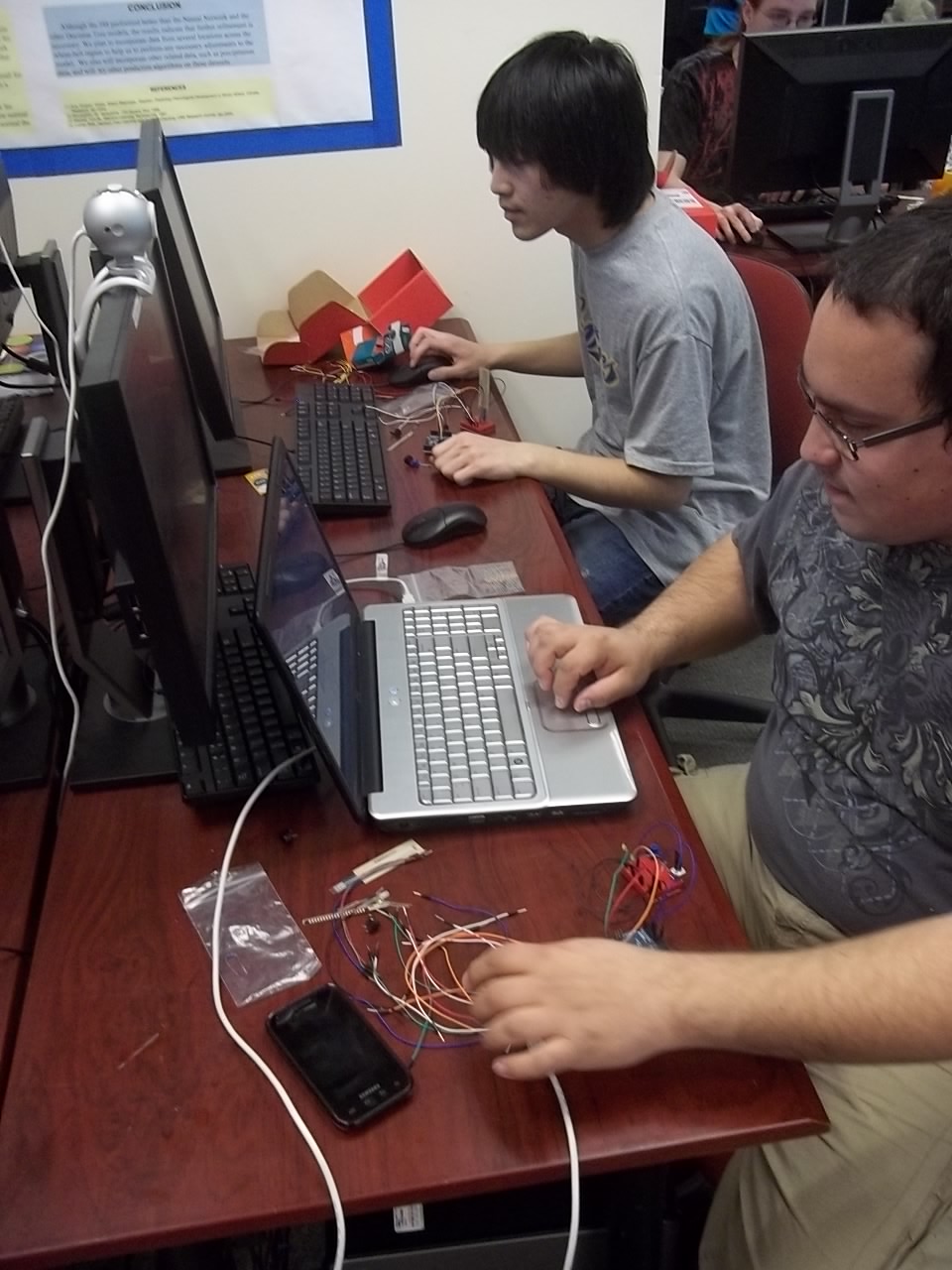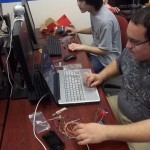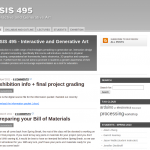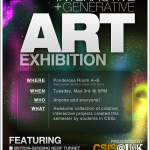
Interactive and Generative Art course – Spring 2011
 During the Spring 2011 semester, I taught a group of 11 students basic skills helpful in creating interactive work, and mentored them in creating a unique, creative project that utilized what they learned.
During the Spring 2011 semester, I taught a group of 11 students basic skills helpful in creating interactive work, and mentored them in creating a unique, creative project that utilized what they learned.
My preparation work for this class began several months before the course was actually offered, and was the result of being awarded the Kelly Grant the previous summer. Using this funding, I was able to spend a large amount of time sharpening my own skills, developing new projects and getting faculty and students excited about the new wave of interest sweeping the web about DIY and open-source hardware.
Development of course material
 During the latter part of the Fall 2010 semester, I was asked by the chairperson of the Computer Science department at UNK if I would be interested in directing my efforts towards developing some course material for a possible future course about the kind of work I had been pursuing earlier that year (interactive art, multi-touch surface computing and others).
During the latter part of the Fall 2010 semester, I was asked by the chairperson of the Computer Science department at UNK if I would be interested in directing my efforts towards developing some course material for a possible future course about the kind of work I had been pursuing earlier that year (interactive art, multi-touch surface computing and others).
This sounded like a fantastic idea to me, so I started developing course material immediately. From the very beginning, I knew I wanted to focus on the interactive art frameworks Processing and Arduino, with supplemental material about specific uses for these frameworks.
From my own personal experience as a student at this university, it was very important to me to explore alternative teaching methods to engage students in ways they were not expecting. Of critical importance to me was keeping formal tests, quizzes and homework to an absolute minimum and focusing coursework on more personalized techniques. I intended the course material to be reinforced through hands-on workshop-style labs, wherein personalized mentoring could be paired with qualitative evaluation. This way, I could keep an eye on each student’s individual progress, while reducing monotonous academic pressure.
All of the curriculum I generated for this course was made freely available on the web in the form of a simple WordPress installation. While the website does contain a large amount of content for the course, I tried hard to use the content more as a scaffolding, rather than the direct information to be delivered in class. Instead, class time was used to cover the essence of the material, while allowing for student questions and alternative lines of thought. If a student was especially interested in that day’s topic, they could easily visit the website and explore it in more detail.
Visit the CSIS 495 course website
Teaching the class
 Once all courseware had been developed, a class was offered to students for the Spring 2011 semester as an independent study, and we were able to get 11 students interested enough to sign up for the class.
Once all courseware had been developed, a class was offered to students for the Spring 2011 semester as an independent study, and we were able to get 11 students interested enough to sign up for the class.
This was actually the first time I had ever had the opportunity to teach other students about something that I was proficient in. I was expecting to be nervous about this fact and require a good deal of assistance in the classroom, but I was happily surprised to find just the opposite to be true. Because I had written all of the course material, I could lead discussions in class and answer student questions with confidence. After the first month or so of teaching, my mentor began coming to class less and less, and eventually stopped coming altogether. I briefed her weekly on the classroom activities, but overall I was completely in charge of the day-to-day direction of the class, an opportunity I am extremely grateful for in retrospect.
Due to the unconventional teaching methods I used in the class, grading was implemented in a fashion that emphasized unique works once a section of material had been covered. For example, every two weeks or so, after finishing a section of material, we had a week-long hack session / workshop wherein the students were asked to do things like create a unique work using an example as a starting point, interface with physical controls to steer a helicoptor on screen and creating a stand-alone musical instrument. I strongly recommend exploring those links to get an idea of what kinds of activities the students participated in.
Final projects and exhibition
Once all of the fundamental course material had been taught, each student was expected to begin working on a final project that utilized what they learned in the course. They were all given the option to make up their own project completely or to choose from a list of interesting projects, adding their own twist to the original idea.
 The last three weeks of the course was devoted to developing the project, so that I could be on hand to offer any advice or additional instruction as needed.
The last three weeks of the course was devoted to developing the project, so that I could be on hand to offer any advice or additional instruction as needed.
At the end of the semester, a public exhibition was planned, so that the students would feel more compelled to put in a fair amount of work. The event was promoted around campus and around town, and was made available to anyone and everyone who wanted to come by. The event was quite successful, even more than I expected! The exhibition was open for the public for four hours, and most of the time saw a rotating crowd of people from all over the community. The students were able to share their work one-on-one with anyone and everyone who wanted more information, and all of the students did a fantastic job of presenting what they learned with a great amount of enthusiasm.